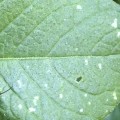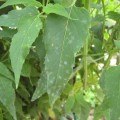Deciduous fruit and nut trees, along with some flowers and biennial vegetables, need a certain number of hours of cold temperatures in order to break winter dormancy. This winter chilling is known as chilling, winter chill, or vernalization. The chilly temperatures actually break down the hormones that are preventing the tree or plant from growing.
Once dormancy has been established, most temperate trees will not resume growth until they’ve had a minimum period of time in low temperatures. Once they’ve reached their minimum, as soon as temperatures warm up and/or days are longer, the tree will start growing and flowering. This is known as “bud burst”. If it’s too early, and there is another freeze, then the flowers (your next crop of fruit) will drop off. Other problems are poor flowering, ineffective pollination due to spread-out blooming or not enough overlap with male flowers, poor foliage production, and weak trees.
Low temperatures equate to below 50 deg F, although 34-45 deg F works best. Some sources only count time below 45 deg F, other sources only use 35-55 deg F. Extreme lows (below 30 or 32 deg F) are not counted, since these temps do not seem to work toward breaking dormancy.
There are two different methods for calculating your areas accumulation of chill hours:
- Chill Accumulation
- the number of hours between 30 & 45 deg F accumulated over the dormant season (traditionally starting November 1)
- however, when there are warm days in this period of dormancy, it cancels out the hours accumulated during the night. Not easily calculated, since it’s not a linear thing, I’d think. This is why the agronomists started developing the Dynamic Model (below).
- Dynamic Modeling using Chill Portions
- Calculates Chilling Portions using 35-55 deg F using consecutive hourly readings for the dormancy period
- Start date for this method is September 1, but I couldn’t determine what date to stop it on…but our chill portions stabilized in mid April (which happens to be our Last Frost Date) and stopped accumulating altogether, by May 3, 2012.
- here’s a link to use this method for your own area: Dynamic Model & Chill Accumulation
Most of Northern California gets 800-1500 hours of chilling; Southern California may get as low as 100-400 hours. An easy way to see if a particular winter is turning out as expected, is if December & January both have about 400 hours of temperatures below 45 deg F, and if this is fairly even (no big swings), then the 800 chill hour minimum is easily reached.
My weather station in Redding, CA, recorded 1539 chill hours between 30°F and 45°F in 2012. As for Chill Portions, I calculated ours using the Dynamic Model, and came up with 97 Chill Portions in 2012.
UC Davis has calculators for many California counties here.
The number of chill hours required varies by variety or cultivar for each fruit or nut tree, but here are some guidelines:
- almonds: 250-500
- apple: 500-1000
- apple (low-chill): 400-600
- apricot: 300-800
- cherry, sour: 1200
- cherry: sweet: 700-800
- chestnut: 400-500
- fig: 100
- filbert (hazelnut): 800
- kiwi: 300-800
- olive: 200-300
- peaches & nectarines: 500-800
- pears: 700-800
- pears, Asian: 350-450
- pecan: 250
- persimmon: 100-200
- pistachio: 800
- plum (American): 3000
- plum (European): 600-800
- plum (Japanese): 250-700
- plumcot: 400-600
- pomegranate: 100-150
- quince: 300
- walnut (Persian): 500-700
There are chemical sprays that people in warm climates can use to artificially break dormancy, but if your tree requires less chill hours than your area has, it increases the likelihood that the tree will “bud burst” and flower before the last frost. This means that the flowers open on the first warm day, then they are all killed in the freeze that comes before spring really hits.
Carrots
Carrots and other biennial vegetables, like beets, need chilling before they can flower.
Foxgloves
Digitalis, Foxgloves, will not flower unless they have some cold temperatures. They will just stay as leafy rosettes.





I dont have any hourly data ; how to Calculate Chilling Hours and Chill Units from Daily
Maximum and Minimum Temperature?
I don’t know of a way, but I’m sure you could get an approximation for your area by talking to nurseries in your area. There are also lots of maps of chill hour averages available online. Try searching for “Chill hour maps” or “chill hours” + your city or region.
Good evening and thank you for this information I live in Copperopolis,CA a few miles south of your location. I relocated from the mid west zone 4 . we don’t worry about chill hours. Still struggling to find the best apple tree and other fruit trees for hotter and drier then Hades, Copperopolis any advise on choosing the best fruit trees? Thank you, Michael
Hi Michael – I can commiserate! We live in Redding, CA, which is also Hades in the summer.
For fruit trees, I always rely on guidance from Dave Wilson’s Nursery (http://www.davewilson.com/). They’ve got a ton of information for backyard orchards. They will have good advice on which apples might do well for you.
Good luck!
-Lisa